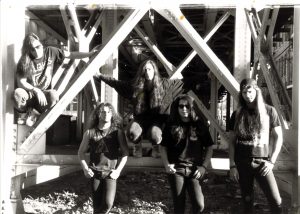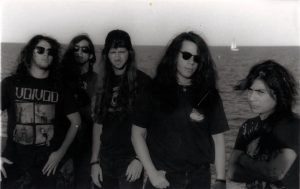
SINDROME… the lost thrash band of Illinois… who despite featuring members of Terminal Death, Death Strike, Master and Devastation hit brick wall after brick wall in their quest for thrash metal mania. Now unlocked from the crypt these underdogs of the first wave thrash movement have a second chance…
It seems hard to believe in this day and age of bands and labels apparently releasing every last recording known to mankind, where even the most rudimentary efforts get pressed up onto limited, multiple-versioned formats, that there was a time when putting out a proper record often (but not always) meant paying your dues in the form of demo recordings, gigging and building up a fan base. The metal world has thrown up a long list of groups whose demo and live recordings have gone on to be held up in high esteem, but also served as the only documents of that band’s existence.
One such band, revered from the release of their debut demo in 1987 to this very day, to the point that Century Media has pulled together a compilation of the band’s two demo recordings is Sindrome. Hailing from Chicago, Illinois, the band members already had a pedigree prior to forming that, on its own, would have indicated something special was afoot.
“Shaun Glass [bass] and I grew up together,” says vocalist Troy Dixler. “He was in Terminal Death and I was in Devastation. We knew Chris [Mittleburn, guitars] from his time in Deathstrike and Master in the Chicago area. After Devastation played with Master at their very first Chicago show, all three of us quit our bands and formed Sindrome. Shaun knew Tony [Ochoa, drums] from the local scene and we had him come down and rehearse with us. With regard to the original line-up, it happened organically and we worked well together. Our goals were like most bands; get signed to a label and tour the world.”
With that in mind, the quartet began writing and rehearsing in earnest, and it wasn’t too long before the band had sufficient material written to record their first demo tape. Unlike an awful lot of contemporary bands who would venture into their rehearsal room with a Walkman or a cheap-and-cheerful studio for their first output, Sindrome skimped and saved to make their mark in as good a studio as they could. The end result was ‘Into The Halls Of Extermination’, a powerful recording that could easily have been released officially (at a time when many similar demos were pressed straight to vinyl (e.g. Hallows Eve’s debut), alongside some particularly eye-catching artwork.
“We recorded at Tanglewood Recording Studios in the Chicago area,” remembers Troy. “Back then it was very expensive to record in a 24-track studio and we paid for the recording ourselves. We were very proud of the songs. Looking back on the production it captured a raw sound, but could have been done better if we had a producer that had more experience. The artwork was done from a local guy named Dan Scholtz.”
In those days, bands got noticed by getting out there and gigging and by getting in contact with like-minded bands and fans across the globe. Remembered to this day for actively flyering every local show, Sindrome also built up an extensive database from fanzines, magazines and other sources, such as every last thrash metal fan in the ‘Penbangers’ section of Metal Forces magazine, who would then be sent professional, full colour printed mailouts. Sindrome also completed two tours in 1988, one opening up for a Whiplash/At War tour and the other as support for Death on their ‘Scream Bloody Gore’ tour.
With all that hard work under their belts, it wasn’t long before labels came calling. Almost 30 years later, Sindrome’s name remains linked to stories of rejecting all such offers in the hopes of securing a deal with a major label that ultimately never came through. A tale often told in musical circles (the world of Northern and Southern Californian punk in the late-’70s spring to mind), but in Sindrome’s case, one where the actual truth was far more mundane. As Troy relates: “We had multiple labels interested in signing Sindrome. Over the years the story has been said that we were holding out for a major label but the untold story of Sindrome was us [being] constantly plagued with line-up changes. We suffered a serious line-up change in 1988 when Chris decided to leave the band. At that time Chris and I co-wrote ‘Into The Halls Of Extermination’ together and him leaving the band put us in a tough spot. We couldn’t sign to a label without a guitar player let alone replacing our main song writer.
“Chris was a bit older than the rest of us during the time we recorded and toured,” Troy continues. “He had a few kids, a real job and the rest of us were looking to Sindrome as our sole focus. It would have been much more difficult for Chris to up and leave his life than us and that ultimately that lead to the split. At the time we went on tour in 1988, we had Erv Brautigam with us playing second guitar even though he didn’t record on ‘…Halls’ so sticking with two guitar playe rs was natural.”
rs was natural.”
Losing momentum, the band took time to re-group and write new material. Chris was replaced with Rob Welsh, and the departing Erv Brautigam was in turn replaced by Mick Vega. By 1991, the band were sufficiently confident to head back into the studio. This time heading to Morrisound in Tampa, Florida, the band came out with their second demo tape, ‘Vault Of Inner Conscience’; while the sound had changed considerably (“it’s really like two different bands with my vocals tying them together”), it wasn’t as if the latest incarnation of Sindrome weren’t able to cut the song-writing or performance mustard by any means. However, despite further promotional work including the remastering of ‘Into The Halls…’ in 1992, the band hit more line-up turbulence that ultimately would spell the end of the band for good.
“It was very difficult to replace Chris,” Troy recalls. “It took us a few years to re-group and release ‘Vault Of Inner Conscience’. By that time our writing style and sound had changed considerably with Rob Welsh and Mick Vega both playing guitar in the band. Once we finally released ‘Vault…’ years later, we ended up parting ways with Rob Welsh who [had been] the main songwriter along with me. We tried to replace Rob with Ken Savich who moved to Chicago to join us, but it never worked out as Ken didn’t write any new material with us during his time in the band. It’s hard enough to replace one key song writer let alone two. Once we split with Rob there was no way we could recover.”
While the band was gone, the songs and the recordings have lived on in underground circles ever since. At times overshadowed by the musical trends of the day, there has been a recent resurgence in interest in the band, leading to Century Media collecting the two demos and a live recording for ‘Resurrection – The Complete Collection’, at long last giving Sindrome the vinyl treatment they never had in the day.
“We are all proud of the songs we created in Sindrome,” Troy concludes. “The fact that Century Media decided to re-release all the material in 2016 is a testament that the music still lives on, [but] there’s no doubt in any of our minds that Sindrome would have been much bigger had we not gone through the multiple line-up changes and were able to put out a full album. Thanks for giving us the opportunity to help spread the news because that is truly the only way we are going to get it known.”
Copyright © 2024 Iron Fist Magazine. All Rights Reserved.